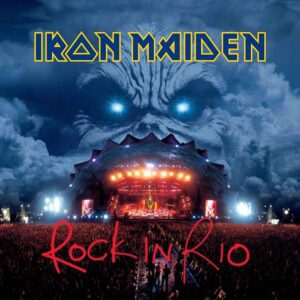There has been a lot of talk about Iron Maiden, one of the most influential bands in the history of rock, who are thrilling fans with another massive tour, “The Future Past,” where the band seems to disregard their age. The recent performances have been so full of energy and quality that fans are clamoring for another live album.

It is impossible, on these grounds, not to remember Steve Harris and company, who gave us two unforgettable live performances: “Live After Death” in 1985 and “Rock in Rio” in 2000. These epic concerts have left an indelible mark in the memories of fans, but they are also the subject of debates and discussions among the band’s supporters. Let’s see how these two performances compare and divide the fans’ opinions.
 “Live After Death,” recorded during the “World Slavery Tour” in 1984-1985, is often considered one of the best live albums in the history of rock music, holding its own against iconic live records like Deep Purple’s “Made in Japan” and The Who’s “Live at Leeds.” This live album represents the pinnacle of the band’s first decade, when they conquered the world with their innovative music and extraordinary stage setups. The most perfect and incisive lineup created an engaging experience for the audience. Many fans appreciate this live album for its nostalgic charm, representing the golden years of the band when they solidified their status as metal legends. The setlist is a collection of timeless classics, from the powerful riffs of “Aces High” to the wickedness of “The Number of the Beast” and the grandeur of “Hallowed Be Thy Name.” For many fans, “Live After Death” is synonymous with strong emotions and indelible memories of their youth and passion for Iron Maiden.
“Live After Death,” recorded during the “World Slavery Tour” in 1984-1985, is often considered one of the best live albums in the history of rock music, holding its own against iconic live records like Deep Purple’s “Made in Japan” and The Who’s “Live at Leeds.” This live album represents the pinnacle of the band’s first decade, when they conquered the world with their innovative music and extraordinary stage setups. The most perfect and incisive lineup created an engaging experience for the audience. Many fans appreciate this live album for its nostalgic charm, representing the golden years of the band when they solidified their status as metal legends. The setlist is a collection of timeless classics, from the powerful riffs of “Aces High” to the wickedness of “The Number of the Beast” and the grandeur of “Hallowed Be Thy Name.” For many fans, “Live After Death” is synonymous with strong emotions and indelible memories of their youth and passion for Iron Maiden.
 On the other hand, “Rock in Rio” from 2000 is evidence of Iron Maiden’s longevity and ongoing relevance. It was recorded in 2000 during the famous festival in Brazil, known for attracting a massive crowd of enthusiastic fans. This live performance was a triumph for Iron Maiden, showing that even after years in the industry, they maintained an unparalleled power and relevance. The setlist included songs from various periods of their history, including tracks from the album “Brave New World,” which marked the return of singer Bruce Dickinson and guitarist Adrian Smith after a few years of absence. The Rio de Janeiro performance was characterized by spectacular stage setups and breathtaking lights, creating a magical and engaging atmosphere. It is appreciated for its overwhelming energy and spectacular production, with lights, fireworks, and an oceanic crowd of passionate fans. “Rock in Rio” symbolizes the reunion and the ability to keep up with the times, demonstrating that the boys from the West End are still a force to be reckoned with in the music industry.
On the other hand, “Rock in Rio” from 2000 is evidence of Iron Maiden’s longevity and ongoing relevance. It was recorded in 2000 during the famous festival in Brazil, known for attracting a massive crowd of enthusiastic fans. This live performance was a triumph for Iron Maiden, showing that even after years in the industry, they maintained an unparalleled power and relevance. The setlist included songs from various periods of their history, including tracks from the album “Brave New World,” which marked the return of singer Bruce Dickinson and guitarist Adrian Smith after a few years of absence. The Rio de Janeiro performance was characterized by spectacular stage setups and breathtaking lights, creating a magical and engaging atmosphere. It is appreciated for its overwhelming energy and spectacular production, with lights, fireworks, and an oceanic crowd of passionate fans. “Rock in Rio” symbolizes the reunion and the ability to keep up with the times, demonstrating that the boys from the West End are still a force to be reckoned with in the music industry.
Despite the strengths of both live albums, fans are divided on which one is the best. Some argue that “Live After Death” represents the authenticity and essence of the band’s origins, while others prefer “Rock in Rio” for its spectacle and demonstration of a band that still knows how to enchant the audience. The debate about which performance is superior also reflects fans’ musical preferences and their personal connection with the band. Undoubtedly, both are exceptional live recordings that have made an impact depending on how they were experienced. While fans may be divided on their preferences between the two performances, one thing is certain: both concerts have showcased the band’s incredible skill and charisma on stage. The iconic power of “Live After Death” and the spectacular grandeur of “Rock in Rio” have both left a lasting impression in the hearts of fans, a testament to the timeless power of Iron Maiden in rock music.
Let’s stay in touch
Copyright ©Antonio Biggio MMXXIV. Tutti i diritti riservati